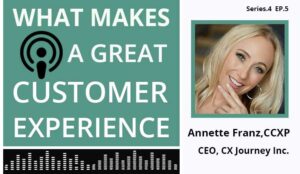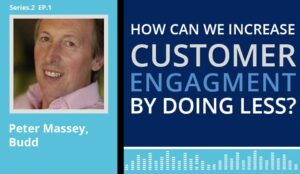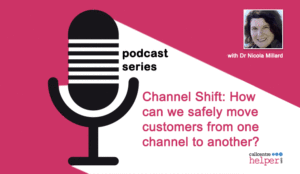The Contact Centre Podcast: Series 4 Episode 5
Annette Franz starts our conversation by discussing some of those common blockers that many of us face in trying to create great customer experiences.

In our conversation, we also talk about using customer feedback to improve customer experience, understanding the impact of emotion and creating great customer journey maps.
To listen to the podcast directly from this web page, just hit the play button below:
The Contact Centre Podcast – Episode 23:
What Makes A Great Customer Experience?
This podcast was made possible by our sponsor Natterbox.
Podcast Time Stamps
- 2.15 – Using Customer Feedback
- 6.01 – Customer Personas
- 10.10 – The Emotional Experience
- 14.59 – Journey Mapping
- 21.45 – Personalisation
Here is a Transcript to the Podcast
Charlie Mitchell: So the first question that I have for you is a very broad one: if the customer experience matters so much, why do you think that it’s often so poor?
Annette Franz: That’s a great question. I love that question. I think that probably the best answer is, is that it’s really not taken seriously. Not all executives have aligned and signed on and really you’re still putting profits over people. So while it is such an important concept in such an important thing that businesses deliver a great customer experience, there are still plenty of companies who don’t quite get that yet.
We talked before we came on the air about my new book. In the last chapter of my book is an open letter to CEOs about exactly this. The importance of the customer and to the business. Obviously if we don’t have customers, we’re not in business and the importance of customer experience and the importance of why do we have to prove ROI or show ROI, focusing on a great customer experience when that’s what the business is all about. So specifically to answer your question, I just think that there aren’t enough CEOs who’ve gotten on board and are open to doing something about it.
Charlie: Yeah, I think that’s very true. And I also think a point that aligns very well with that is that many organizations are still kind of stuck in traditional ways of doing things. And I think for example, in the contact centre, we see this a lot in where you have internal promotions and that often means that things carry on as they are instead of keeping up with the latest thinking and having outside perspectives brought in. So I think that processes are not often reconsidered in a modern context and businesses remain in silos. Is this silo approach where departments stay isolated from one another still a big issue that you’re seeing?
Annette: Absolutely. And I’m glad you brought that up because I was going to just add a note about… notice how I mentioned the fact that the CEOs aren’t aligned and the executives aren’t aligned, they’re not on board. And this then, it doesn’t help the siloed situation at all. Because there are certain departments that do want to focus and know that they need to focus on the customer. But when that happens, it becomes a siloed experience for the customer as well. It’s not a seamless experience. They feel like they’re working with five different companies when they’re interacting with five different departments or five different areas of the business. And so yeah, absolutely the silos are a problem. And again, it stems from the top for sure.
Charlie: It’s just a whole very interesting topic. And I know you mentioned your book there and understanding your customers is a key part in this new customer experience thinking and it’s a huge part of customer experience design as well, I think. So, how should we be using customer feedback, in your opinion, to improve the customer journey?
Annette: Yeah, absolutely. First I want to just say that there are a couple of different ways that we get customer feedback. Most people think immediately about surveys. But, there’s a lot of survey fatigue happening right now because everybody under the sun is surveying. So we can get feedback from customers yes, from surveys. But then also from things like customer advisory boards, online reviews, panels. There are a lot of different ways. And then we also can get customer “feedback”. I’ll just call it feedback, I’ll just kind of bucket it into that. Because it’s the data that they leave behind, and I like to say the breadcrumbs of data that they leave behind as they interact and transact with us, because that data tells us a lot about the experience and if they’ve purchased again, what they’ve purchased, where they purchased, all those different kinds of things.
So I think that an important thing is to take the feedback, the actual survey or however they providing the feedback plus that data and put it together to really have a robust analysis of the experience. And then that feedback’s got to be used in a lot of different ways. First of all, it can’t just sit where it was gathered. It has to be analysed, it has to be shared out into the organization, it has to be responded to. So we’ve got to close the loop. And I always say you close the loop in five different ways. And it’s at the personal level, it’s at the departmental level, it’s at the strategic level, it’s with our employees and it’s with our customers. And so the feedback has to be socialized and then it has to be operationalized. And that’s a really key thing. The bottom line is, it has to be used. We can’t just “collect feedback” and do nothing with it. There’s no point in even listening to customers and asking for feedback if we’re not going to do anything with it.
Charlie: Yeah. I think that’s just a very interesting point in general, having actionable feedback and having a feedback plan that encompasses the three A’s, I’ve heard: actionable, accessible, and audible.
Annette: Yeah, I love that.
Charlie: Which I think is a very nice approach to it. Yeah, I think it’s very interesting. And I know one of the feedback messages that I hear a lot about when it comes to customer experience design is creating personas. And that’s still a key way that companies are assessing their customer journeys. What are your views on using personas for customer experience kind of things?
Annette: Absolutely. I totally agree. So you mentioned my book, right, and the book is called Customer Understanding. And it’s the three ways to do just that. They’re listen, characterize and empathize. Listen is all about the feedback and the data that we just talked about. Characterize is all about the personas, and empathize is journey maps.
So specific to personas, personas are a way for us to really deeply understand who our customers are. They’re research-based personifications of groups of customers with similar needs, pain points, problems to solve, jobs to be done, that kind of thing. And that is absolutely where we need to start when it comes to designing the experience. It doesn’t get us to the personalized level, the individual level, but it gets us to a much closer level so that we can ultimately then design the experience. Because as we’re experienced designers, we can’t design for every individual, that would be absolutely insanity. But we can design for these groups of customers with those similar needs and pain points and jobs to be done. And that gets us that much closer to designing an experience that will certainly make the customers happy.
Charlie: I think, yeah, I think personas, as you said there, really can be useful. I think one problem that many businesses have when they use personas – this is why I really wanted to fixate on this method of customer experience – is that often we forget that customer behaviour changes. And maybe five years ago my grandparents would never use social media in my life and then all of a sudden my Nan’s on Facebook.
Charlie: So customer behaviour and how you interact with them will change over time. And I think this is a very interesting topic. But quickly moving away from my Nan’s social media habits, I think one interesting thought that’s recently come on is, “Well, this is a theory that all great customer experiences tend to be effortless.” Or is there a case, do you think, of maybe adding some friction into the customer experience to systematically blow the customer’s socks off with great customer service? Which approach would you advise?
Annette: Well, I don’t believe that we should add friction just to be a hero. I believe that we should design the experience to be easy, simple, effortless. And that’s what’s going to blow people’s socks off. If we… if we start to – what’s a good word for it? – I’m thinking of the word like it’s fake, right? If we falsely insert some friction points just to wow the customer, then we’ve got bigger problems. So let’s just keep it simple for ourselves and let’s design the experience that meets the customer’s needs and make it simple. Like I said, simple, easy, effortless. We can be heroes without creating scenarios that make us the hero. Yeah, absolutely.
Charlie: Yeah. I think the principle of recovering a situation through good service so the customers will be more loyal than if the failure never happened in the first place, it’s great in principle, but I mean it must be so hard to achieve, and often it will require a large amount of micromanagement. So the big lesson for me in terms of customer experience is to leave nothing to chance, maybe. Would you agree with me in the fact that such micromanagement really does work or can that be dangerous?
Annette: No, I absolutely agree with you. Like I just said, let’s just take the time to understand our customers, understand their needs, pain points, problems, just all jobs to be done, all of that. And then design the experience that’s right for them. And I don’t think that’s micromanaging. I think that’s being proactive and then we don’t have to micromanage. If we’re proactive about it, then we’re doing the right thing. And it’s keeping our customers happy as a result.
Charlie: Yeah. It’s a very interesting topic. And I’m going through these customer experience trends quite quickly here, but another one that really does come from just – I’m going to keep flowing with them – because I recently read another one about customer experience and another trend is customer emotion. And I recently read that great customer experience considers customer emotions. So why do you think customer emotion within an experience is so critical to understand?
Annette: Well, I’m going to give you a scenario. And I love to tell this story. I have a client in the construction industry. When we first started doing our journey mapping workshops, and I explained to them that “When we do our journey mapping, what we have to capture is what the customer is doing, thinking and feeling.”
And as soon as I said “feeling”, their eyes rolled back in their head, “What, we’re a bunch of macho guys. We don’t talk about feelings.” And then I made him use pink post-it notes for the feeling part of the journey too, so that was pretty good.
But you know what the funny part was, when we were done mapping and they saw how they made their customer feel, whether it was happy or it was “You made us feel like you don’t care about us”, those were the most impactful parts of the workshop of creating that journey map.
Because now they could see immediately, “Oh, we’re doing things great here. Oh boy, we really broke things here.” That kind of thing. And that’s really the importance of emotion. And when customers are happy and have a positive experience then they’re going to advocate, they’re going to buy again. They’re going to do all the things that we hope and want them to do. So I just thought that’s a fun way to share how impactful the emotions can be, for sure.
Charlie: Yeah, I think that’s a very interesting story. And I think maybe the next step to customer emotions would be defining the emotions that you want to drive. And I think that can be a very important part here. And I think that once again comes back to understanding your customers. Is that understanding your customers and applying certain emotions to the customer journey, is that realistic?
Annette: Yeah, I think it is, it is. So the exercise that I talked about at the beginning of this question was a current-state journey map. If we work with the customers then to design the future state by doing future-state journey mapping, then we can again ask them, doing, thinking, feeling during that exercise. And of course nobody’s ever going to say, “We want to feel like you don’t care about us at this point.” But using that type of an exercise and listening to customers and really understanding them is what’s going to help us to identify what we want them to feel throughout the entire experience. So it always starts with the customer. So that’s the important thing to remember.
Charlie: Yeah. Yeah. I think that’s very interesting, this topic. And I think another key part of this emotion approach that I’ve talked a little bit about recently is the peak-end rule. Do you think this is something that every customer experience professional should be aware of?
Annette: Yeah, absolutely. Absolutely, I do. Years ago I wrote a post that said, first impression, last impression or lasting impression? So that’s where the impressions happen. The moment that you first start interacting with a brand, there’s only one chance for a first impression. And what we end up leaving them with is that last impression, and we want that to be strong. But if we do a great job throughout the entire experience, now we’ve got a lasting impression as well. And so I think that’s really important, but I do believe that the peak-end rule is something to pay attention to, that it’s an important concept for sure.
Charlie: Yeah. Yeah. I think that’s a very interesting point. And I think maybe this whole topic of emotional intelligence in especially the contact centre is something that is going to become more and more part of our conversations in customer experience. And I think this is a good point to take a quick pause before we continue with our conversation, to hear a quick message that we’ve created on behalf Natterbox, who have supported us in producing this podcast.
This podcast is sponsored by Natterbox. Natterbox is a cloud telephony platform that gives businesses a 360-degree view of their voice interactions. It enables companies to accelerate productivity, transform the customer experience, and improve data integrity all within Salesforce. Over 500 organizations worldwide rely on Natterbox to set new standards in customer service and drive measurable increases in sales efficiency, competitive advantage, and organizational success. To find out more visit www.natterbox.com/voice360. Once again, that link is www.natterbox.com/voice360, which is available in the description box below. Thanks.
With all this in mind of what we spoke about so far, when we next look to change our customer journey maps, what one thing do you think we should perhaps be looking to change?
Annette: Thinking about the customer journey maps. I think it’s less about what we need to change in the maps and more about when should we change. When should we map again? What are the things that we need to think about? And that’s probably one of the biggest questions that I get asked. And I speak a lot about journey mapping and I can almost guarantee you at the end of the presentation, somebody will ask me, “Well, how often should I map, or remap a journey?”
And it’s really thinking about when things change. I know that sounds very vague, but when things change. And that’s a very technical phrase there, “When things change.” But you got to think about how has the business changed, right? Have there been mergers and acquisitions and new products and new services? And those kinds of things.
But also how have the customers changed? And how have environmental factors changed? Speaking of environmental factors, we’ve got a lot of those going on in the world today, especially. So as we think about how business changes, how a customer changes, how competitors change, how we’re doing things differently. And importantly the feedback that we’re getting from our customers as we listen to our customers to say, “Hey, you know what, this experience is broken.” Or, “This part of the experience is broken. Now we need to go and revisit what’s happening. How do we need to do things differently? What can we learn from our customers that we now need to incorporate and change the experience?” So I think that’s the more important thing to focus on.
Charlie: Yeah, I think that’s very interesting. And I think from my experience with seeing how organizations are using journey maps, I quite often feel, though, that there is a problem in using it as a tool across the business. And the fact that most of the time journey maps are created by outside consultancies and that mindset carries out through the organization, and not enough people take responsibility for implementing it. Do you think this is a problem or are we getting better at that?
Annette: Yes, it is a problem. There are a lot of problems happening with how people do journey mapping, but yeah, absolutely. The one thing that you have to know when you do journey mapping or when you journey map is, you’ve got to have customers in the room. You can’t just do it with a consultant. You can’t just get a group of department heads or folks from different departments sitting around and creating the journey maps. You’ve got to have customers in the room and you’ve got to bring customer data into the journey maps as well. Whether it’s research you’ve done beforehand, feedback that’s coming in on an ongoing basis, whatever it is, but you’ve got to include the customer in those exercises for sure.
Charlie: Yeah, I think that’s a very interesting topic. You said there’s a lot of mistakes that organizations are making with customer journey maps. You know I’m going to know what my next question is.
Annette: We could do a whole podcast on that.
Charlie: That’ll be our follow-up, mistakes to avoid or something like that. Yeah, just very quickly, what kind of other key mistakes are you seeing?
Annette: So we already talked about personas, so not starting with personas. That’s a good one. And personas are an interesting thing too because a lot of times companies have personas, but they’re marketing personas and they’re not the same as what we need in terms of design. I just call them design personas, but they’re too high level. We need the factors that I’ve talked about. What are they doing, thinking, feeling? What are your needs, pain points, problems you solve? Those kinds of things. Those have to be incorporated into the persona development and using the design personas. A couple of other things… let’s see. And related to that is that one map applies to all customers. But of course it doesn’t because all customers are not the same. So you do have to start with a persona.
Annette: Thinking about the map is, “I’m mapped and I’m done.” But that’s not it. The journey map is actually just the beginning. There’s so much more that needs to be done after you’ve created the map. So you can’t view the map just as a pretty picture on the wall and that’s it. There’s so many uses for the map and so many great ways that a journey map can inform your customer experience strategy. So that’s a really important thing.
Annette: I think we just talked about this one too, about having people in the room and creating what we call an assumptive map and not having customers in the room. That’s so important. What else? People start with future-state mapping. But I know you need to start with current-state mapping. You’ve got to understand the current situation and what’s going well and what’s not and what you should keep doing before you go into a future-state mapping. Oh, and one last one then is… my favourite one is that journey maps are only used for the customer experience and that is wrong. They can be used for employee experience, vendor experience, partner experience, whatever else. So journey maps are a great tool and a great process for improving the experience of all constituents.
Charlie: I think that was a lots of very interesting points there. I’m racking my brain to think of other customer journey mistakes that I have come across. But I think one thing that I found works really well for some organizations in terms of this, is once they’ve identified through customer research and personas, as you were talking about, was to create a set of customer commitments that they try to meet at every touchpoint of the customer journey based on the emotions and the values of their customer base. Do you think this is a good thing in principle?
Annette:Absolutely. In principle, yeah, absolutely. I think that’s a great idea, yep. I’ll throw one more out at you and this is a big one. This is not having a budget to do the things that you uncovered in the journey map. So you go and you create this journey map, but you don’t have alignment from the folks around you to do something, to the ones who have to actually go and fix it. So first of all, everybody’s got to be aligned and involved. Who’s going to end up ultimately owning what comes out of the dream mapping? And then you’ve got to have budget in place to then go and fix it, right, to go and do something about it. And that oftentimes does not happen. So again, it just can’t happen in a vacuum.
Charlie: Yeah. I think that fits in very nicely with the first point that we talked about of businesses kind of still being stuck in terms of objectives and alignment and key goals.
Annette: We just came full circle.
Charlie: It was all part of the plan.
Annette:Yes it was.
Charlie: There is one final thing that I really do want to get your opinion on. Because I saw that you’ve recently published an article on the topic of hyper-personalization and I thought this was a very interesting concept. So I wondered if you could just explain what this means to our listeners and the benefits of hyper-personalization and what they have on the customer experience?
Annette: It’s an interesting evolution. Suddenly when everybody’s finally cueing in on the “Hey, we’ve got a personalized.” Now suddenly it’s hyper-personalization. But personalization just came down to a simple things as “Dear Annette” or addressing folks by their names or those kinds of very simple, simplistic types of ways to make the customer feel like they were recognized.
I think in the article I use something along the lines of “Know me.” That was really what personalization was all about. But now it’s “Hear me, know me, understand me and show me.” And that’s all about context and relevance and timeliness. It’s using tools like geofencing and biometrics and all of those kinds of things. So when a customer walks into a store, they’re suddenly recognized, or when you’re just driving near a store, you’re now suddenly recognized and the store sends you an offering via the app or in an email or something like that. So it’s just become a lot more, I don’t know, what’s a good word for it? Crazy.
I think when I wrote the article too, I said again, “You’ve got to have that balance of creepiness versus making sure that privacy and security and all of those kinds of things are upheld and to avoid the creepiness factor.” But when it comes down to hyper-personalization, it can really… we’re talking a lot about context and how we’re looking at things by location, channel, time of the day, the product, the previous interactions we’ve had and all of those kinds of things. And so it all comes together to really provide you this insane experience that suddenly, like I said, hear me, know me, understand me and show me. It’s all happening in real time.
So yeah, it’s a pretty interesting concept. Not a lot of brands are doing it well yet, but it’s coming. I think that’s the cool thing about, like, Netflix and Starbucks and Amazon are probably among the ones who are doing it well. But there’s still a lot of other brands that need to get in on this, and I’m sure we’ll be seeing that happen over the next year or so.
Charlie: Yeah, I think it’s, I think it’s very interesting. I think there’s lots of interesting ways that brands are using data, like the ones that you’ve just said to personalize the customer experience. I think one great example that I’ve heard is using the IVR. Say, there’s a power company and they know there’s an outage in, say, London, and then they can put an IVR message as the customer phones in for an announcement about “If you’re in London, we’re currently experiencing outage.” And quick, give them an update there so they don’t have to go through and talk to the advisor and they can just get the information there. And then I think examples like that can really show the benefit of personalization. I don’t know if there’s any really interesting examples of personalization that you’ve seen out there.
Annette: I don’t right off the top my head. Don’t have examples except for a bad one, which I won’t go into. And it’s also a utility example. As I was listening to you give that example, it goes back to what we were talking about earlier – and again we’re coming full circle here – it’s about simplicity, right? Simple, keeping it easy and effortless for the customer when we’re getting ahead of the curve. When we’re getting out there and we’re being proactive in our messaging and our offers and those kinds of things, it’s keeping it effortless for the customer. And again we talked about emotions. Customers will be delighted when we do things like that. So I think it’s, like I said, I think we’ll be seeing a lot more of that in the next year or so.
Charlie: Yeah, I think the whole topic of personalization and the bad examples, there’s a few out there, as you say. I think one that I saw, this was a few years ago, it was Admiral the car insurance in Britain. They had a policy where they would look at social media data, they would use that to put a personalized quote instead of a generic quote, but that didn’t last long as people didn’t like how they were using their customer data. So there’s lots of interesting ways. They had a nice vision, but it wasn’t a particularly great outcome, I don’t think. But anyway, I’m sure this is a topic that we could speak lots and lots more, as we’ve spoken a lot already about the different parts of the customer experience. So just as a final question, where can our listeners go to hear more from you?
Annette: Yeah, absolutely. Thank you for asking me that. So my website is cx-journey.com. Absolutely a great place to find information about me and also all my contact information is there as well. And feel free to connect with me on Twitter @Annette or on LinkedIn. Look forward to connecting with folks.
Charlie: Excellent. Great. Thank you for joining us today, Annette.
Annette: Thank you. Thanks for having me.
Author: Charlie Mitchell
Published On: 4th May 2020 - Last modified: 26th Sep 2025
Read more about - Podcasts, Annette Franz, Charlie Mitchell, Natterbox, Podcast















